Before the end of the 19th century, August Horch established a company known as Horch & Cie. Motorwagen Werke in Cologne. In 1902 he moved it to Zwickau in Saxony, and in 1904 it was reorganised into a joint-stock company. In 1909, following a dispute with the members of the executive and supervisory boards, August Horch left the company and a few weeks later established a second automobile manufacturing operation, also in Zwickau. Since he could not use his own name, which was a registered brand, he chose a Latin translation instead: the German word “Horch!” (meaning “Listen!”) became “Audi”. The use of this Latin imperative was suggested by the son of one of August Horch’s business partners, a student of Latin, who had followed the discussion about a new name with interest.
Car production began on a small scale, true to Horch’s basic principle of building only “good, strong cars”, but only a few years later Audi had already developed into one of the best-known German automobile brands. It enjoyed success in competition from the very start. Victories in Austrian Alpine Rallies between 1911 and 1914 made the Audi name familiar on the international scene. The Audi Type C 14/35 PS was especially successful, and acquired the name “Alpine Victor”.
In 1921 Audiwerke AG took the motoring world by surprise by unveiling the new Audi 14/50 hp Type K, Germany’s first left-hand-drive car. In making this move, Audi spread its net beyond merely engine and suspension technology and began to channel more energy into the areas of driving safety and ease of operation. The Type M, with a six-cylinder engine, followed in 1923 and the first eight-cylinder Audi model, the Audi Imperator, appeared in 1927.
In August 1928 Jörgen Skafte Rasmussen, owner of Zschopauer Motorenwerke/DKW, acquired a majority interest in Audiwerke AG, the following year merging the Zwickau-based company with his own business empire. When the global economy plunged into crisis in October 1929, sales of large car models with six and eight-cylinder engines collapsed. Rasmussen responded by commissioning Audi to develop a small DKW car with front-wheel drive, and this model was launched highly successfully in 1931. The Audi plant also assembled DKW Front models, in a measure designed to protect jobs.
- 1899 – August Horch establishes A. Horch & Cie in Cologne.
- 1901 – The first Horch car appears on the road.
- 1902 – August Horch & Cie Motor- und Motorwagenbau established in Reichenbach/Vogtland on March 3
- 1909 – Following a disagreement with the supervisory board, August Horch leaves August Horch Motorwagenwerke AG, which had been based in Zwickau since 1904, and founds a new company, also in Zwickau. He chooses the Latin translation of his surname as the name of the new company: Horch (“hark”) thus becomes Audi.
- 1921 – Audi becomes the first manufacturer in Germany to introduce left-hand drive and central gear change as standard.
Auto Union History

The pressure on German car manufacturers had already been growing since the mid-1920s. Automation and assembly lines were the order of the day. American manufacturers were demonstrating the shape of things to come. Cars from the USA were flooding the European market. Those manufacturers that failed to rationalise or join forces with others were left behind. The Great Depression of 1929 put the four Saxony-based car companies under further pressure. The idea of a merger was first floated by the State Bank of Saxony. The companies finally merged on 29 June 1932 to become Auto Union AG.
The companies entering into the alliance were Zschopauer Motorenwerke J.S. Rasmussen AG, which had already belonged to Audiwerke AG since August 1928, as well as Horchwerke AG and the Cars Division of Wanderer Werke in Chemnitz. The company signet depicted four interlocking rings, intended to symbolise the inseparable unity of the four founder companies. The brand names Audi, DKW, Horch and Wanderer were retained. To avoid competition within the new group, each of the four brands was assigned a specific market segment: motorcycles and small cars for DKW, midsize cars for Wanderer, cars in the deluxe midsize segment for Audi, and luxury cars at the top end of the market for Horch.
A further benefit of the merger was that resources were pooled through the centralisation of administration, development, testing, sales and marketing operations at the company’s headquarters in Chemnitz. Auto Union was consequently able to achieve pioneering status in the sphere of science and research: the Central Testing Institute (ZVA) and Central Development and Design Office (ZEKB) performed scientific development work and basic research. Even in those days, materials engineering, consumption research, acoustics measurements, wind tunnel tests and crash tests were common practice.
To raise its public profile, in 1934 the new company decided to get involved in motor racing at the very highest level – Grand Prix – and over the next few years saw its Auto Union “Silver Arrow” models clinch countless races, championships and world records on racetracks around the world.

The Audi badge
The four rings of the Audi badge symbolise the merger four car companies brands. Audi, DKW, Horch and Wanderer, which were combined to form Auto Union in 1932. By the late 1930s, one in four cars in Germany was built by Auto Union AG and sported the four-ring badge on its radiator grille. Auto Union AG was created as a result of this merger, becoming the second-largest car manufacturer in Germany. Auto Union and NSU, which merged in 1969, both made many significant contributions towards the development of the car. AUDI AG was formed from Audi NSU Auto Union AG in 1985. Together with the two traditional companies Auto Union GmbH and NSU GmbH.

The Audi brand. (1930’s)
The first ring in the new alliance of companies
One of the keys to the success of the still young Auto Union was the allocation of a specific market segment to each of the individual brands in order to create a coordinated model range. Specifically for the Audi brand, this prompted the development of the Audi Front Type UW, a midsize car through which the new group was for the first time able to make use of synergy benefits.
The principal feature of the new Audi was its front-wheel drive. DKW’s experience in the domain of front-wheel drive had simply been translated into a midsize vehicle. Its power unit was a Wanderer 2-litre, six-cylinder engine developed by Ferdinand Porsche, the body of the saloon version came from Horch’s body shop, and the Cabriolets were built by the renowned Dresden coachbuilder Gläser.
The Audi Front Type UW – the designation means a Type U with Wanderer engine – finally went into production in the early part of 1933. One year later, Audi’s production operations were transferred to the nearby Horch plant in order to free up capacity at the Audi plant for the rising production output of DKW Front models. With technically revised features and equipped with a tuned-up 2.3-litre Wanderer engine, the new Audi Front 225 was unveiled at the 1935 Berlin Motor Show and remained on the market until 1938. The successor model, the Audi 920, likewise exhibited the hallmark features of a modular system. The chassis, which had now reverted to conventional rear-wheel drive, and the modern-styled body were largely borrowed from the six-cylinder Wanderer W 23 model. This elegant car had a straight-six OHC engine developed by Horch, while the rear axle adopted the DKW floating-axle principle. The first specimens of the new car left the production line at Auto Union’s Horch plant in December 1938. The Audi 920 rapidly became a hit with customers.
This success was brought to an abrupt halt with the outbreak of the Second World War. Production of civilian vehicles was slashed and the group’s operations switched to the production of armaments. The last Audi of this era was completed in April 1940. There would not be another for a quarter of a century.
- 1931 – The world’s first volume-built car with front-wheel drive is introduced: the DKW Front (F1).
- 1932 – The Saxon companies Audi, DKW and Horch and the automotive department of Wanderer Werke merge to form Auto Union AG, with its headquarters in Chemnitz. The company chooses four interlinked rings as its logo.
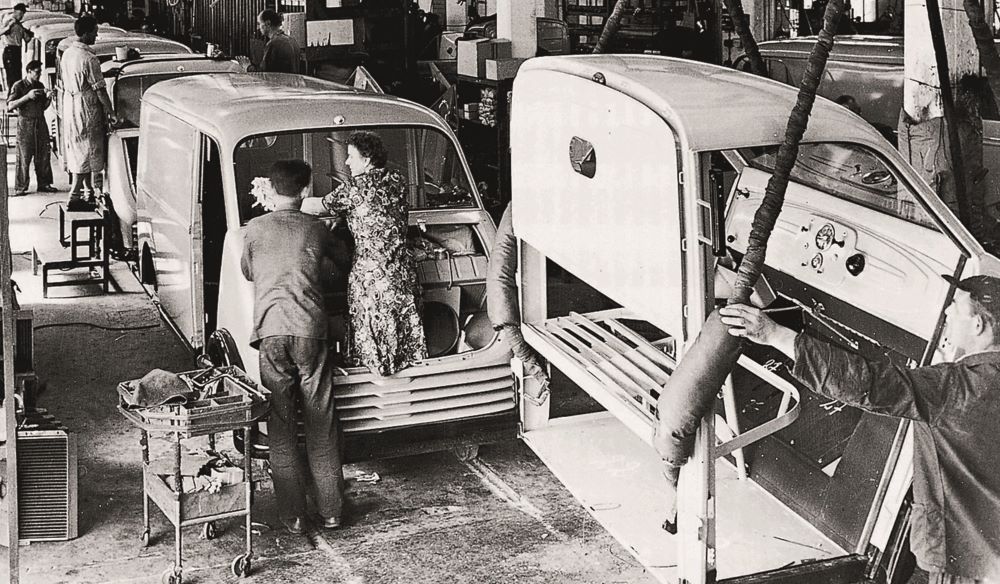
The Audi brand. (1940’s-1950’s)
A new start in Ingolstadt
In 1945, after the war had ended, Auto Union AG’s premises were located in the zone occupied by the Soviet forces, who expropriated its assets and dismantled the plant; the company was removed from the Commercial Register of the city of Chemnitz in 1948. Certain members of Auto Union’s senior management had already moved to Bavaria at the end of the war, and in late 1945 a depot for Auto Union parts was set up in the historic garrison city of Ingolstadt. These tentative efforts to relaunch operations led to the founding of a new company named Auto Union GmbH on September 3, 1949, with the purpose of upholding the automotive tradition of the four rings.
The first products with the four-ring badge built in this era were well-established DKW models with two-stroke engines. These basic but robust and reliable cars and motorcycles were just right for the austere circumstances of the post-war years. The DKW F 89 L rapid delivery van and the DKW RT 125 W motorcycle were unveiled at the Hanover Export Fair in early 1949. These models established automotive manufacturing in Ingolstadt. In parallel, the company was working on a DKW car, which went into production at a new plant in Düsseldorf in summer 1950.

From 1954 onwards, Friedrich Flick gradually acquired a large stake in the equity of Auto Union GmbH. His strategy was to find a strong partner for Auto Union in the medium term. In April 1958, Daimler-Benz AG acquired 88 percent of Auto Union’s shares and in the following year the Ingolstadt company became a fully-owned subsidiary.
- 1945 – Auto Union AG in Saxony is dispossessed by the Soviet occupying forces; the factories are dismantled.
A few months after the war, a central depot for Auto Union parts is set up in Ingolstadt to supply the vehicles traveling in Western zones. - 1948 – Auto Union AG is deleted from the Commercial Register of the city of Chemnitz.
- 1949 – The newly founded Auto Union GmbH is entered in the Commercial Register of the city of Ingolstadt. Production of the DKW RT 125 W motorcycle and the DKW F 89 L high-speed van begins in former garrison buildings.
- 1958 – Auto Union GmbH is acquired by Daimler-Benz AG.
- 1959 – A new plant goes into operation in Ingolstadt for the production of the DKW Junior small car.
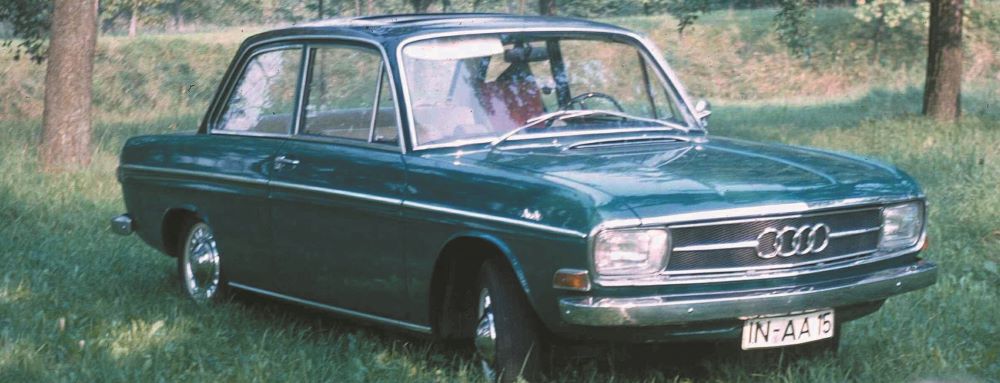
The Audi brand. (1960’s-1970’s)
In autumn 1965 the Ingolstadt car company, still called Auto Union GmbH in those days, introduced a new model with a four-stroke engine for the first time after the war at the Frankfurt Motor Show. This new car needed a new name, and thus the name “Audi” came into being. Founded in 1909 by August Horch, Audi had become noted for the manufacture of elegant six and eight-cylinder cars in the 1920s and 1930s. From 1932 onwards, together with DKW, Horch and Wanderer, the Audi brand formed part of the merger Auto Union AG, which was symbolised by the emblem of the four rings.
In the middle of the 1960s the German car manufacturing industry was in a state of upheaval and Auto Union GmbH in Ingolstadt was experiencing a crisis with its DKW two-stroke cars. Daimler-Benz AG, the major shareholder in Auto Union from 1958 to 1964, developed a four-cylinder four-stroke engine for its ailing subsidiary. In autumn 1964, Volkswagenwerk AG took over the Ingolstadt company, and the work at hand was completed under the supervision of VW. Chief technician Ludwig Kraus installed the water-cooled inline 4-cylinder engine with a capacity of 1695 cc, 72 bhp output and the unusually high compression ratio of 11.2:1 in the body of the last DKW model, the F 102. At the outset, the first Audi did not bear any model designation; later it was called the Audi 72 reflecting its engine output.
The Audi 72 played an important role in the brand’s history. Introduced on August 13, 1965 as the Auto Union’s first post-war car with a four-stroke engine, it ushered in a new era for the Ingolstadt-based manufacturer and the abandonment of the two-stroke engine. Between 1965 and 1968 85,000 units of this model, which revived the distinguished Audi name, were sold.
Automotive journalists praised the new Audi for being a practical and well-finished car, with a reliable engine and the best in driving characteristics. The four-cylinder four-stroke engine became the basis of all further models in the Audi range. With the introduction of various model versions, the model designation “Audi” was supplemented by the relevant number of horsepower. In 1966 the Audi 80 and the Audi Super 90 appeared in the same guise. Two years later the Audi 60 and Audi 75 models were included in the range. The new Audi 100 was officially introduced in 1968 and paved the way into the top end of the midsize class. From then on the future belonged to the Audi brand.
In 1969 Volkswagenwerk AG engineered the merger of Auto Union GmbH and the Neckarsulm-based NSU Motorenwerke AG. The new company now became known as Audi NSU Auto Union AG and had its registered office in Neckarsulm. The new Audi NSU Auto Union AG with head office in Neckarsulm came into being. The company name, which was unusually long and difficult to remember, became a matter of debate at the beginning of the 1980s; this was due to the fact that NSU ceased to be used as a product name after the NSU RO 80 went out of production in 1977. The Board of Management decided to rename the company AUDI AG, which took effect from 1 January 1985. From then on both the company and its products have borne the same short and succinct name. In view of the change of name, the head office moved from Neckarsulm to Ingolstadt.
- 1964 – Auto Union GmbH’s capital is doubled to DM 160 million; Volkswagenwerk AG initially takes over 50.3 percent of the shares.
- 1965 – Auto Union GmbH presents a new model with four-stroke engine. Its name: Audi. This marks the end of the DKW two-stroke era.
- 1966 – Auto Union GmbH becomes a wholly owned subsidiary of Volkswagenwerk AG.
- 1966 – The last DKW passenger car of the Type F 102 leaves the assembly line.
- 1969 – Auto Union GmbH merges with NSU Motorenwerke AG (established 1873) to form Audi NSU Auto Union AG.
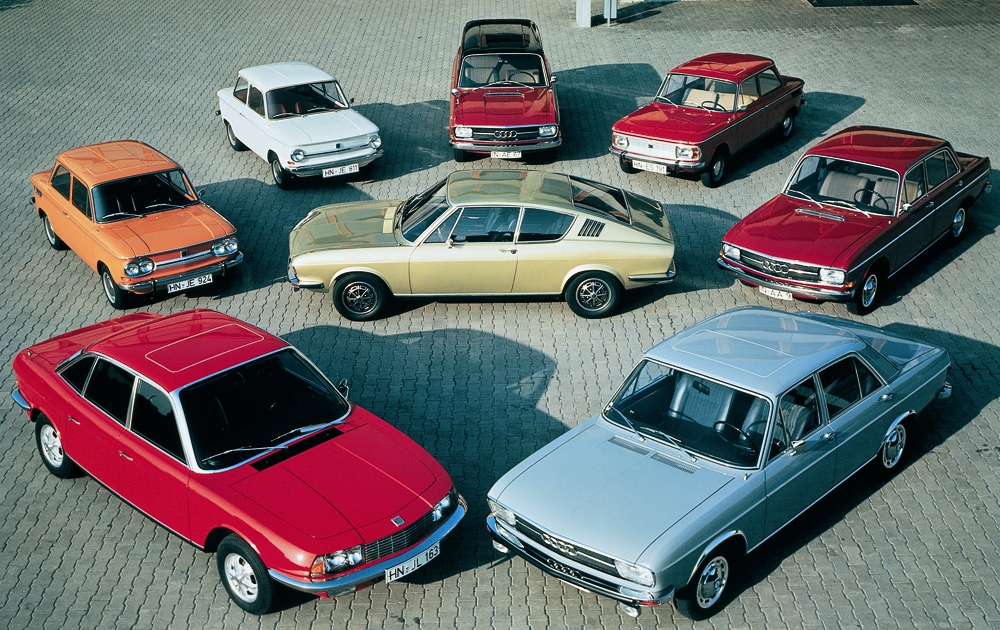
The model range of Audi NSU Auto Union AG in 1971
(pictured clockwise): NSU Ro 80, NSU Prinz 100 TT, NSU Prinz 4, Audi 75 Variant, NSU 1200, Audi 60 L, Audi 100 LS, Audi 100 Coupe´ S (centre)
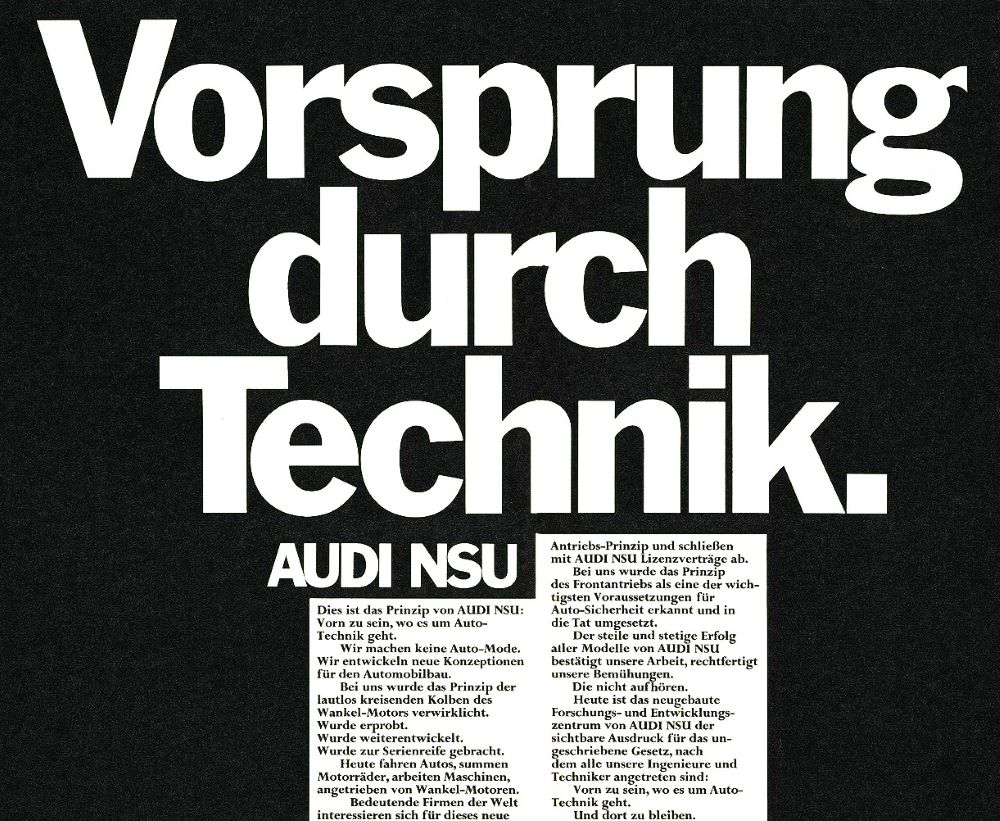
The new slogan “Vorsprung durch Technik” made its first appearance in a large-sized ad in January of 1971.
The extensive range of Audi and NSU models covering a wide variety of engines and drive concepts prompted the coining of a new advertising slogan in 1971, and one that has effectively been the company’s mission statement ever since: “Vorsprung durch Technik”.
It was entirely in this spirit that the first-generation Audi 80 (B1 series) was launched in 1972, with a glittering array of new technical features such as an OHC engine series and self-stabilising steering roll radius. By the time production of this first generation ceased, over one million units had been built.
1974 saw the appointment of Ferdinand Piëch as Ludwig Kraus’ successor, initially as Head of Technical Development. Over the “Piëch era” Audi was transformed into a highly innovative car manufacturer. This period also witnessed the gradual raising of the Audi brand’s positioning. The five-cylinder engine (1976), turbocharger technology (1979) and quattro four-wheel drive (1980) are eloquent testimonies to the success of this drive.
The company underwent a change of name from Audi NSU Auto Union AG to AUDI AG in 1985. Ever since then, the company and the products it builds have shared the same name. The company’s headquarters were moved back to Ingolstadt. Audi’s subsequent progress has witnessed a sensational range of technical innovations: fully galvanised bodies, the most aerodynamic volume-built saloon of its time, the broad-based use of petrol engines with exhaust turbocharging, the development of economical direct-injection diesel engines, the aluminium body, the first hybrid vehicles, petrol direct injection and the manufacture of luxury-class cars with eight and twelve-cylinder engines are just some of the many mileposts that document the emergence of the Audi brand as a manufacturer of premium cars.
However, the traditional name elements NSU and Auto Union no longer appeared as part of the company’s new name. Therefore, in order to legally protect these names, two subsidiaries were founded in 1985; Auto Union GmbH in Ingolstadt and NSU GmbH in Neckarsulm. Since then the primary tasks of these two entities has been the upholding of the company’s tradition, the creation of a collection of historic vehicles and the collation of archive material relevant to the history of the company. Both of these tradition-upholding companies have been integrated in the department Audi Tradition since 1998.
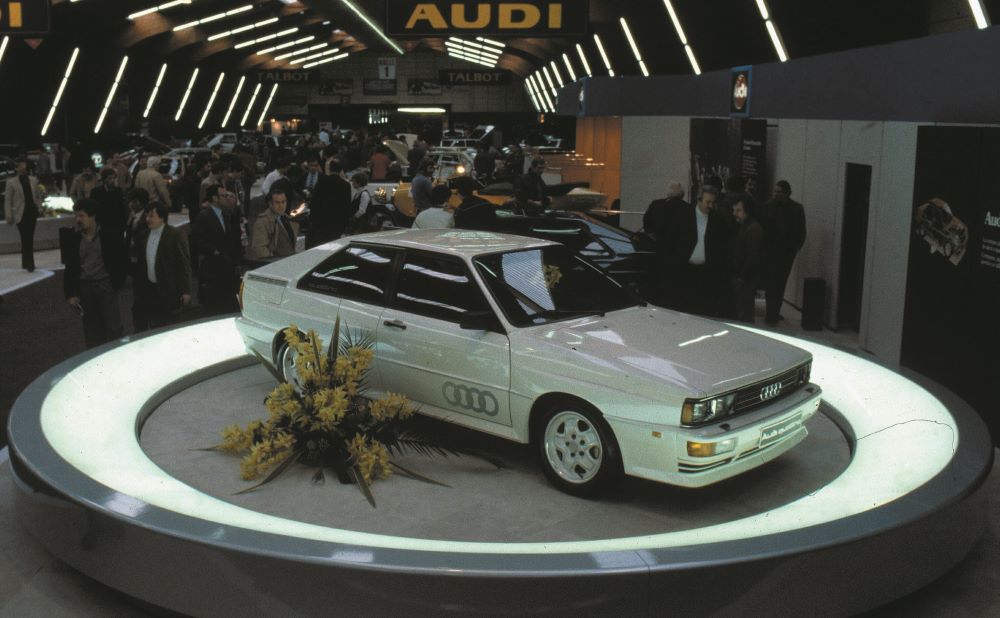
- 1980 – Audi quattro: The first production car with permanent all-wheel drive is presented in Geneva.
- 1982 – The third generation of the Audi 100 goes down in the annals of technology history as the world’s most aerodynamic production sedan, with a drag coefficient of 0.30.
- 1985 – Audi NSU Auto Union AG is renamed AUDI AG. This means that the products and the company share the same name.
In September of the 1986 model year, Audi launches the Audi 100 and 200 models with fully galvanized bodies. - 1986 – The third generation of the Audi 80 excels with its excellent aerodynamics and fulli galvanized body. As part of the preperations for production, the body shop and paint shop are extensively modernized.
- 1989 – With the 2.5-liter, five-cylinder TDI, Audi introduces the direct-injection turbocharged diesel engine.
- 1990 – Audi presents the Audi duo, a hybrid model based on the Audi 100 Avant.
- 1993 – AUDI HUNGARIA MOTOR Kft. is established in Győr (Hungary) as a fully owned subsidiary of AUDI AG. The plant is officially opened on October 12,
- 1994 – Audi takes a quantum leap in automotive engineering with the market launch of the Audi A8 with its revolutionary aluminum Audi Space Frame (ASF).
- 1998 – The agreement for the takeover of Lamborghini is signed on July 24.

You must be logged in to post a comment.